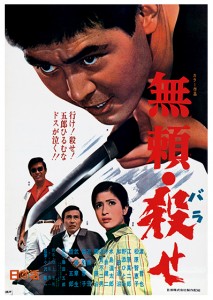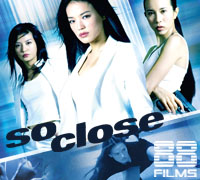AKA: Gangster VIP 6
Director: Keiichi Ozawa
Cast: Tetsuya Watari, Chieko Matsubara, Eiji Go, Kenji Imai, Goro Mutsumi, Koji Wada, Hiroshi Kondo, Fujio Suga
Running Time: 85 min.
By Kelly Warner
“I don’t get involved in yakuza feuds,” says Goro Fujikawa, the Outlaw antihero who seriously gets involved in a new yakuza feud practically every time he hops off the train. Goro’s not fooling anybody, least of all the audience. We’ve heard these kinds of things from him before. The Outlaw series is a yakuza crime saga caught on a carousel, taking us whizzing past similar sights and sounds every time we take a ride. Goro doesn’t want to get involved… but then he gets involved. Goro meets up with the Chieko Matsubara of the Week… and they fall in love. Goro dishes out justice with a blade… and shambles off to an uncertain fate by each film’s end. The sixth Outlaw film, titled Kill! (the exclamation point is part of the title), is a bit different because we know it’ll be the last time we ever see Goro. Despite that, the film plays just like all the others, and doesn’t offer any closure for the series at the finale. It’s almost like the series just ran out of gas.
In the opening moments of Outlaw: Kill! the Toyu Clan attacks yakuza boss Matsunaga (Michitaro Mizushima) of the rival Iriezaki Clan. Not only does Matsunaga manage to defend himself, the old man goes a bit overboard, hacking his would-be assassins to death in the streets for everyone to see. That’s just fine by Toyu boss, though. As the man in control of the Toyu Clan, Kenwachi (Fujio Suga) willingly sacrifices his men as he attempts to achieve dominance over the city of Keihin. His rival Matsunaga going to jail for seven years is almost as good as seeing him dead. With Matsunaga out of the way, Toyu declares open season on all rival yakuza in Keihin, putting a target on the backs of the Iriezaki boys and any other yakuza in the city.
Tough guy drifter Goro Fujiwara (Tetsuya Fujiwara) just happens to be passing through Keihin at this point. And though Goro at first claims to have zero interest in siding with either Toyu or Iriezaki, his link to an old cellmate in the Iriezaki family lets us know pretty early on whose side he’s ultimately going to fall in with. Goro can lie to himself all he wants that he’s not ready to get involved with more warring gangsters, but he’s too much of a standup guy to idly watch as bullies pick on the weak.
Much of Outlaw: Kill! has Goro acting the mentor to young yakuza. It’s an interesting but natural turn for Goro, who started out the series as stupid as the youth he’s now taking under his wing. But it also tells something rather unflattering about Goro: that, though he knows the game is rigged and the bosses are monsters, he still can’t break away from the yakuza lifestyle completely. It’s not like Michael Corleone raging about, “Just when I thought I was out, they pull me back in,” because Goro never really leaves the life. He walks the tightrope between a past he wants no part in and a future he’s unable to stick with, unable to fully commit to either.
In addition to Goro’s failings at going straight, he continues to have a weird love life with women that all look the same, as Chieko Matsubara returns yet again as a new character who’s destined to fall for Goro. The formula is familiar: she’s a complete stranger, then she hates him, then she realizes he’s not so bad, and then she can’t live without him. Chieko Matsubara is perhaps the most wasted part of the Outlaw series. She’s put through the paces of playing with the same drama time after time while Tetsuya Watari gets to experience actual character growth and other returning actors get to play something wildly different in their respective sequels. Her character seems a complete afterthought in the Kill! (I’m undecided if this hurts or helps the film). It’s like they realized they’d gone five films with Chieko Matsubara as a romantic lead and figured they might as well make it the complete six.
Though much of the film’s drama feels overly familiar, Kill! does provide us with Outlaw’s best villain. Character actor Fujio Suga is positively loathsome as Kenwachi. A character actor best known for supporting parts in Yasujiro Ozu dramas and the Zatoichi series, I’ve seen Suga in many films but his presence is usually regulated to the background. In Kill!, Suga demands your attention. The character is written as the lowest of the low who sees his men as petty pawns in a game of chess and Suga seems to have a fun time in the role. In the film’s climactic finale (which calls to mind the first film as well as the punk rock flair of Stray Cat Rock), Goro takes on the Toyu Clan in a nightclub. Kenwachi and his goons are seated below the dance floor, looking up the skirts of young girls, when Goro comes in with a knife. The brawl plays out below while the oblivious dancers enjoy their lives above, even as blood sprays on the glass that separates the two worlds. Maybe there’s some social commentary here about the separation of the young upper class and the criminals who kill themselves for scraps just beneath their feet? Or, more likely, it’s just a cool action sequence to finish off the film.
With the exception of praising actor Fujio Suga’s performance and director Keiichi Ozawa’s action sequences, I realize that I’m not exactly heaping praise on the final Outlaw film. But that’s not really the film’s fault. It’s just that, by this point, I’m feeling acute Outlaw burnout. The Outlaw series is fun but it repeats its themes and characters with more regularity than I would’ve liked. By the end of Outlaw: Kill!, it’s as though the seventh film was just over the next horizon. Maybe it’s for the best that they stopped here, though. I enjoyed the Outlaw series, for the most part. I didn’t really dislike any of its six films and I loved one of them. However, by this point, it was becoming clear that the series had run its course and had nothing new left to offer.
Kelly Warner’s Rating: 6.5/10
About this release: The six-film Outlaw: Gangster VIP series hits DVD and Blu-ray with a 6-disc box set for the first time in the West thanks to the good folks at Arrow Video. It comes with 3 DVDs and 3 Blu-rays, with each disc sporting two films plus special features. (I only viewed the Blu-rays, so some DVD layout may differ.)
Special features include trailers and photo galleries for each film, a visual essay by Kevin Gilvear, and an audio commentary on the first film by Jasper Sharp. The visual essay is basically a rundown of the entire series, with Gilvear talking plot points and characters. (The visual essay begins with a warning that you should wait to watch it until you’ve seen all six films. It’s wise to follow this piece of advice.) Gilvear mixes a fan’s praise with a critic’s cynicism and has some fun with the “cloning” operation involving Chieko Matsubara.
Jasper Sharp’s commentary is a little less focused than I would’ve liked. Sharp spends much of the commentary talking about Nikkatsu’s history and the film careers of those who worked on the film, but I would’ve liked to have known more about the production of Gangster VIP and the series that followed.
The real highlight of the extras is the 40 page booklet with writing by Chris D., Mark Schilling, and Kevin Gilvear. Chris D. puts the Outlaw series in a historical perspective, Mark Schilling lends some information about the real-life gangster who wrote the books on which Outlaw is based, and Schilling and Kevin Gilvear write biographies for the three directors who worked on the series. The best part of the booklet is a reprinted interview with director Toshio Masuda conducted by Schilling which originally appeared in Schilling’s book No Borders, No Limits: Nikkatsu Action Cinema. It’s an entertaining talk with one of Japan’s best directors who still remains largely unknown in the West.
In regards to the picture and sound quality of the films… sadly, the best film looks the roughest. Gangster VIP shows signs of age and wear that the other films don’t. The remaining five Outlaw films look great on Blu-ray. I obviously have no idea how they looked when they originally debuted in cinemas in the 1960s, but I think the films look as good as or better than you would expect. The sound is also handled nicely, with clashing daggers ringing loudly over the speakers.
If you’re interested in this set, you should know it is a limited edition release of 3,000 copies in the US. After that, who knows? I give the first film, Outlaw: Gangster VIP, the strongest possible recommendation for fans of gangster movies and fans of Japanese cinema in general.
The rest of the films – Outlaw: Gangster VIP 2, Outlaw: Heartless, Outlaw: Goro the Assassin, Outlaw: Black Dagger and Outlaw: Kill! – aren’t quite up to the quality of the original, but there’s some entertainment to be had with the stylish action and a strong lead performance from Tetsuya Watari. If you do decide to dive into the Outlaw set, my advice would be to space the sequels out a bit, as it’ll make for a more entertaining and less repetitive film viewing experience.





Great review Kyle. It’s been an entertaining ride reading your thoughts on each of the Outlaw Gangster series, one that’s had me feel disappointed that none of the sequels could maintain the originality of the first installment, but at the same time breathing a sigh of relief that my wallet won’t need to be as light as I was anticipating.
Back to Van Damme? 😛
If Arrow ever releases the films individually (I see they’re doing that with the Battles Without Honor titles), then I’d definitely recommend picking up the first Gangster VIP film. But yeah, the big set costs a pretty penny and is more difficult to recommend as a blind buy.
Our Fearless Leader has already given me my next JCVD assignment, so yep, I have another one of those coming up!